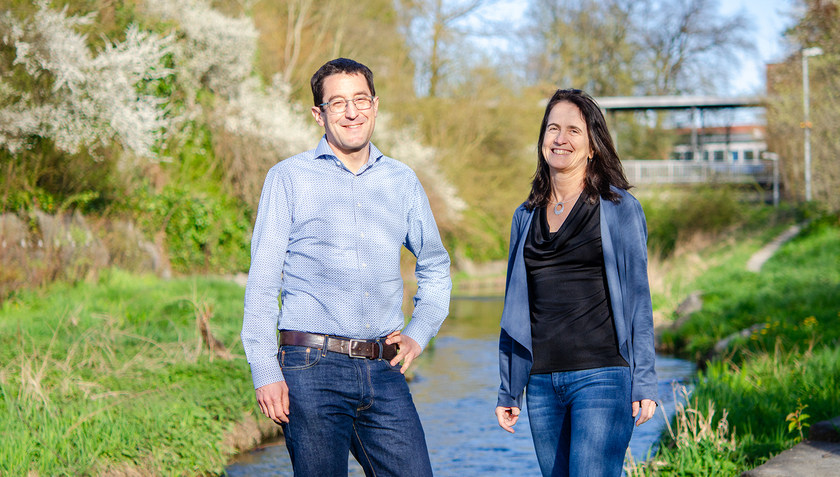Chapter 1: “The blue-green spirit from the research initiative will live on”

An interview with the two co-leaders of the research initiative, Prof Catherine Graham from WSL and Prof Florian Altermatt from Eawag about the innovative value of the research initiative Blue-Green Biodiversity BGB, the close cooperation between the two research institutes and blue-green thinking.
We are in the throes of a global biodiversity crisis. What is the situation in Switzerland?
Florian Altermatt: Biodiversity is also in a worrying state in Switzerland. Over a third of all species are endangered. That is more than in the neighbouring countries. At the same time, we have a very high biodiversity potential. Our country, in the heart of Europe, is part of highly diverse biogeographical regions and has an above-average proportion of aquatic habitats such as lakes, rivers, streams and small bodies of water. Species in the transition zones between water and land are particularly at risk.
The population has a very different view: a survey has shown that the majority of people rate the biodiversity as good to very good.
Catherine Graham: Landscape change is a gradual process. People get used to minor changes very quickly: a new house here and a drained pond there. That doesn’t provoke an outcry. People hike in the countryside and still see a lot of nature. Overall, however, the changes over the decades have been dramatic.
Altermatt: Biodiversity requires space and a degree of “disorganisation”. The Swiss like to see wilderness in a national park or far away when travelling, but it is not necessarily appreciated on their own doorstep. The urge to tidy everything up and prevent natural dynamics is fatal for biodiversity and landscape quality. In addition, there is sometimes small-scale and compartmentalised thinking. For example, nature reserves often border directly onto intensively utilised agricultural land without any sufficient transition and buffer areas. Although there are valuable wetlands, the stream that flows in and out may be canalised and therefore far from their natural state.
Research can play a crucial role in tackling the biodiversity crisis by deepening understanding, developing solutions and laying the foundation for effective measures to protect biodiversity. In 2020, Eawag and WSL launched the “Blue-Green Biodiversity” research initiative, which focusses on the interrelationships between aquatic and terrestrial ecosystems. What’s new about that? After all, ecosystem research began over 200 years ago.
Graham: Ecosystem research does indeed have a long history. Step by step, we are gaining a better understanding of the processes taking place around us. Sometimes there is a leap in the knowledge gained. This is the case, for example, when new technologies are applied and researchers with different backgrounds work together on an interdisciplinary basis and exchange ideas. These were precisely the success factors of the research initiative of the two research institutes. The participants are biodiversity researchers who have focused on either blue or green habitats. Now they have worked together on blue-green interfaces.
What kind of interfaces are these?
Graham: There are countless blue-green interactions that can only be uncovered using an interdisciplinary approach. For instance: if the object of research is a bird species, then the habitats in which it lives, its food resources, the survival rate of its young and so on are investigated. If the object of research is a river, the water quality and structural diversity are analysed. This isolated view leaves many interactions and influencing factors undetected. Viewed together, many surprising connections emerge: for example, one of our studies found that insects that emerge from aquatic systems are much more nutritious for birds than terrestrial ones (Chapter 1). Intact and diverse bodies of water are vital for these insect species, even if at first glance once the insects leave the water they appear to have nothing to do with aquatic habitats. We were only able to understand and quantify this connection with a cross-institutional research initiative.
Altermatt: What is also different from 200 years ago, or even 10 years ago: today, we have huge data sets and new methods, such as environmental DNA or remote sensing, which enable new and larger quantitative approaches. Our research initiative was able to draw on such data sets from aquatic and terrestrial ecosystems and bring them together. For example, we have shown that terrestrial and aquatic food webs are structured differently.
Graham: In the first phase of the research initiative, which only lasted one year, we did not collect a single new data point, but only analysed existing data from national or cantonal monitoring programmes. Citizen science projects, which often bring together large and valuable amounts of data, are also important. Involving the population in research projects also raise awareness of biodiversity preservation issues.
Are the research results relevant to practice?
Altermatt: From the outset, all projects have not only focused on publication in specialist journals, but have also sought cooperation with the federal government, cantons and practitioners. The objective of many projects was to meet the needs of practitioners and to put the research findings into practice as efficiently and quickly as possible. One example is the project on the effectiveness of the ecological infrastructure for amphibians in the canton of Aargau (Chapter 4).
How exactly did it come about that Eawag – as an aquatic research institute – and WSL – with its focus primarily on terrestrial habitats – joined forces in this scope and breadth in terms of biodiversity?
Altermatt: It’s not as if Eawag and WSL have never worked together before! There has always been cooperation in various areas, such as water body revitalisation. In 2019, however, the ETH Board created the possibility for submitting specific research initiatives between institutions. The directorates of WSL and Eawag took advantage of this opportunity, and a small group of researchers outlined the BGB research initiative over the Christmas holidays. This raised a great deal of energy and excitement. A few weeks later, we got the green light from the ETH Board. Then Covid came. We had to organise everything in online meetings and didn’t see each other for months. At the same time, a very close and successful collaboration began.
Less than ideal conditions for an interdisciplinary project in which new contacts and relationships were to be forged.
Altermatt: But it worked out! Looking back, I don’t think the online meetings were such a bad idea. For example, we never had to think about whether the meeting would take place at WSL or Eawag. The virtual space made it easy to meet. This allowed us to exchange ideas much more frequently than would have been physically possible due to the different locations of the research institutions. I was quite surprised that some of the researchers from the two institutions didn’t even know each other, despite their proximity to the institutions. Many worked with colleagues from all over the world, but not within the ETH Domain. The initiative has also provided a very important long-term impetus here.
Graham: Once the money was approved, the next step was to distribute the funds. We decided that project ideas should come from the scientists and not be dictated from above. Creativity was given free rein. Each and every person had the opportunity to submit something, even people who had not yet done much in the blue-green field but were bubbling over with ideas. Everyone was enthusiastic and highly motivated – and put their heart into it!
And how did blue and green come together?
Graham: All 24 approved projects had one thing in common: the project management always consisted of two people – one from Eawag and one from WSL. This also applies to the overall project management. It wouldn’t have worked without this equality.
Altermatt: This tandem principle led to great added value! A classic example: someone at WSL is researching urban ecology, and an environmental engineer at Eawag is working in the field of urban drainage. Without the research initiative, these two researchers would probably not have developed and carried out a project on biodiversity in urban areas. In this case, one plus one definitely equals more than two!
Was the collaboration always harmonious?
Graham: It went much better than we expected. Especially in view of the large number of researchers involved. Of course, not everything was always perfect, but communication worked and problems were quickly resolved. The momentum that developed was breathtaking at times.
Altermatt: I have never experienced such good cooperation. And this despite – or perhaps because – the structures and cultures between the two research institutes are different. The initiative’s output speaks for itself: in the first phase, we had a comparatively small budget, but a very big impact – both in terms of publications in high-calibre scientific journals and on the practical side. Blue-green issues are increasingly being taken up, including by nature conservation organisations. It is important that our research findings are channelled into political decision-making processes, concrete measures and the educational landscape in order to bring about positive change.
What is the biggest challenge in implementing blue-green thinking?
Altermatt: The artificial demarcations between blue and green habitats, some of which are rooted in our thinking, are persistent. At federal and cantonal level, the various habitats are sometimes accommodated in completely different offices, departments or sections, so that synergies and cross-habitat approaches are often dependent on the strong initiative of the specialists working there. Legislation, such as forest and water legislation, is also not always harmonised.
Is blue-green the new trend?
Altermatt: Absolutely! Our objective is to sensitise everyone involved so that they think, collaborate and act in a more cross-disciplinary way. We need to raise interest and demonstrate the need to think blue-green and initiate new forms of cooperation. It’s about broadening perspectives – and then maintaining them.
Graham: The postdocs and doctoral students we have trained are already thinking more broadly. This new generation has strong blue-green skills and interests. In order to establish a new integrated culture in the preservation of biodiversity, the new-found momentum must not be allowed to wane. Regular meetings, workshops and conferences on the topic of blue-green biodiversity are needed. What makes me very optimistic: many of the teams with WSL and Eawag researchers want to continue working together in the future, which emphasises the success of the research initiative. The new alliances will be continued. However, collaboration must also be supported financially. At present, for example, the National Fund penalises projects with two equal project leaders.
Altermatt: The research initiative has shown that we can and want to work together in a swift, close, respectful and constructive way. The WSL and Eawag researchers involved perceive themselves much more strongly as a biodiversity community than before. I am sure that the spirit will live on and that there will be many more joint blue-green projects in the future.
Key messages
> The close collaboration between biodiversity researchers at Eawag and WSL has led to exciting, close and constructive interactions and cooperation that have made it possible to work on issues in an integrative manner.
> The integration and consolidation of huge data sets from the aquatic and terrestrial realms have enabled new insights into the dependencies and interactions between blue and green ecosystems.
> the practical orientation of the research projects allowed the knowledge to be transferred into application.



